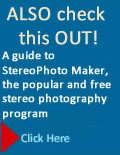
CyberLink has a free CyberLink BD & 3D Advisor that tells you if your PC is ready for Blu-ray Discs. These discs are the only ones used to distribute 3D HD movies. To check out your system, click the button above.

Zalman makes polarized 3D monitors.

When getting a new Blu-ray drive for your computer, make sure it plays Blue-ray 3Ds.

Sony's VAIO® F Series 3D laptop has a built-in Blu-ray Disc™ player, 3D sync transmitter and 3D active glasses to view 3D movies and photos in Full HD 1080p. Pressing a 3D button converts 2D video to 3D in real time. You can also connect the PC to a compatible 3D HDTV with an HDMI cable.

Spatial View's 3DeeSlide (
www.
spatialview.com) is developing a lenticular screen attachment for laptops.

The Toshiba Dynabook Qosmio T851/D8CR can display glassless 3D and 2D simultaneously.
On a standard PC you can view anaglyphs and freeview side by side stereo pairs without any additional hardware or software. However, to view 3D movies and games, and make viewing 3D photos easier, you need a 3D enabled system. The necessary software and hardware will be built into some new laptops and desktop models, but you can also upgrade existing systems.
Until autostereoscopic displays become more affordable and widely available, the most common 3D systems on computers will be based on active shutter glasses or passive polarized glasses. Which you use depends in large part on the monitor and other elements in the system. One component common to both systems is an optional Blu-ray Disc (BD) drive that let's you view 3D HD movies.
Regardless of which type of monitor you buy, you may be at the mercy of the manufacturer for not only drivers but also stereo players that display your 3D stills and movies. For example, with a Zalman polarized monitor, you have to use their stereoscopic player. This will change over time as more players are developed.
Software is needed to view 3D stills and play movies because there are so many ways the content can be stored and viewed. In the past, it was necessary to encode a stereoscopic movie for each viewing method. For example if you wanted to be able to see the same movie with anaglyph, shutter, and polarized glasses, you'd have to create a file for each. Software now converts any source file to the system's desired format in real time.
Most systems also come with software, like that from TriDef, that converts 2D still images and movie frames to 3D on the fly. The results are not as realistic looking as content shot through two offset lenses, but they are 3D.
On all of these systems, when you are performing tasks such as word processing you can easily switch to the conventional 2D mode.
Shutter Glass Systems
Currently most 3D computer systems use shutter glasses that require a fairly fast computer, a 3D monitor that refreshes at least 120 Hz a second (twice the rate of most monitors to avoid flicker), a 3D graphics card designed to deliver HD content to a 3D display (visit Nvidia.com). You also need shutter glasses supported by the graphics card you are using. Finally you need software that supports displaying your 3D still images.
- To play 3D movies, you need a Blu-ray drive and player software such as Cyberlink's Power DVD Ultimate edition. This program can also convert 2D content to 3D on the fly using what they call TrueTheater 3D Playback.
- To view 3D still images you need player software such as StereoPhoto Maker or the very primitive Nvidia 3D Vision Photo Viewer. By the time you read this Fuji may also have upgraded their FinePix software to view 3D images.

This typical 3D notebook comes with a Blu-ray player, shutter glasses, and a transmitter that keeps the shutter glasses in sync with the movie frames. Courtesy of Toshiba.
Polarized Glass Systems
Systems based on polarized screens and glasses are much like ones based on shutter glasses in terms of needing software to operate. The main difference is that on a polarized system the two images in each stereo pair are interleaved row by row so the vertical resolution is cut in half. The monitor is viewed using a pair of polarized glasses which are much less expensive than shutter glasses.
MINOR POINTS
Optical devices are called
drives when connected to a computer and
players when connected to TV sets.
Magnetic media is spelled disk and optical media is spelled disc.

